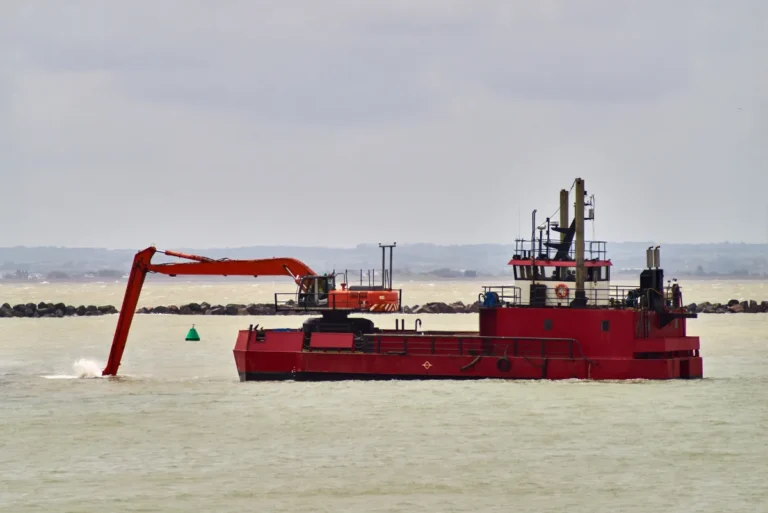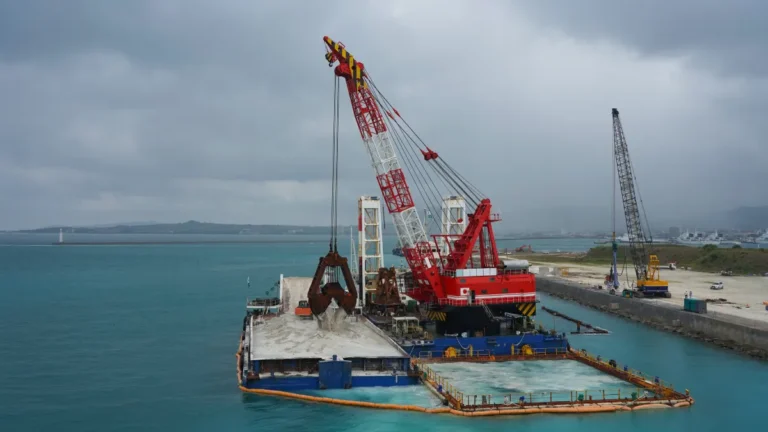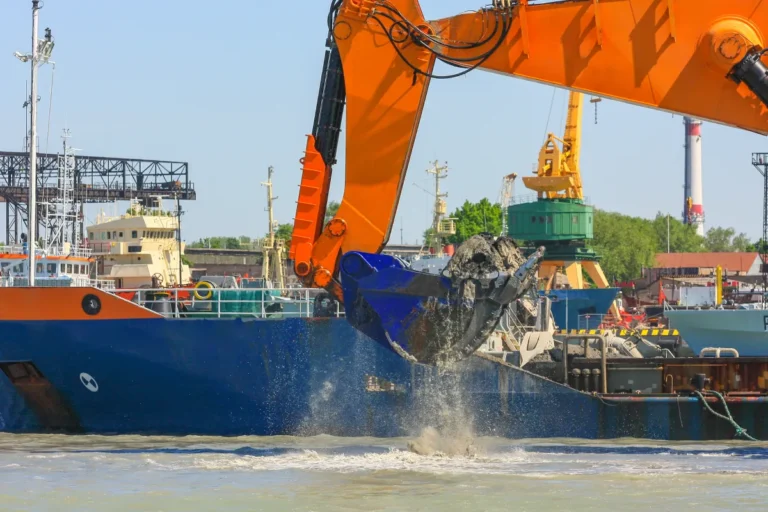Selecting and operating the right sand dredge pump is critical to the success of any sand removal or dredging project. Whether used in mining, river restoration, or construction, these pumps must deliver high flow rates, withstand abrasive wear, and operate efficiently across varying site conditions. This article explores the key performance factors that influence a dredge pump for sand, including flow rate, head, and wear resistance. It also offers practical guidance on selecting the right sand dredging pump, understanding performance trade-offs, and maintaining the equipment for long-term durability and reliability.
Principle of Sand Dredge Pump
A sand dredge pump is a specialized type of dredging equipment designed to efficiently move sand, sediment, and other abrasive materials from one location to another. These pumps are integral to operations in mining, river restoration, beach nourishment, and construction projects that require the removal or relocation of large volumes of sand.
The primary function of a sand dredging pump is to generate high-volume, high-efficiency suction and discharge of sand-laden water or slurry. Unlike pumps used for clean water or light slurries, a dredge pump for sand is engineered to handle coarse particles, abrasive solids, and high concentrations of suspended material without clogging or excessive wear.
Key components of a sand dredge pump include:
- Impeller: Typically made of high-chrome or wear-resistant material, the impeller creates the centrifugal force needed to move sand through the system. It is often open or semi-open to prevent clogging from larger particles.
- Casing: The volute casing directs the flow of slurry and is designed with thick walls or lined with wear-resistant materials to withstand erosion.
- Liners and Wear Plates: These internal protective elements reduce maintenance frequency and prolong the pump’s lifespan by absorbing the brunt of abrasive wear.
- Seals and Bearings: Heavy-duty seals and bearing systems are required to withstand the harsh operating conditions typical of sand dredging applications.
In comparison to general-purpose dredging pumps, a sand dredging pump is optimized for high-wear environments and high solids content. It features a larger passage size to prevent clogging and uses materials and design features that enhance durability. A dredge pump for sand is not just about volume—it must perform reliably under extreme abrasion and variable site conditions. These pumps are specifically designed for continuous operation in sand-heavy applications, where traditional pumps would often fail or require frequent maintenance.
Flow Rate: Why It Matters and How It’s Measured

Flow rate refers to the volume of slurry or material that a sand dredge pump can move over a specified period, typically measured in gallons per minute (GPM) or cubic meters per hour (m³/h). In sand dredging applications, the flow rate directly impacts the speed and efficiency of the operation. A properly selected dredge pump for sand should achieve the required flow rate without compromising wear life or operational stability.
Several key factors influence the flow rate of a sand dredging pump:
- Pump Size and Impeller Design: Larger pumps with high-efficiency impellers can handle higher flow rates. The geometry and blade configuration of the impeller affect how much material can be moved per revolution.
- Motor Power and Rotational Speed: Higher horsepower and faster RPMs increase the pump’s ability to move larger volumes. However, excessive speed can accelerate wear, particularly when pumping abrasive materials such as sand.
- Suction Conditions: The efficiency of sand suction depends on water depth, pump submergence, and obstruction-free inlet flow. Poor suction conditions reduce effective flow and may introduce cavitation.
- Discharge Piping: The diameter, length, and bends of the pipeline influence flow resistance. Longer pipelines or those with sharp turns can decrease the overall flow rate due to frictional losses.
An optimal flow rate ensures the pump meets production targets while maintaining component integrity. If the flow is too low, the system becomes inefficient. If it’s too high, the internal components of the sand dredge pump experience accelerated wear due to high-velocity abrasive slurry.
To optimize flow without increasing wear, operators should:
- Match the pump and impeller size to the required throughput
- Maintain optimal RPM settings based on the material characteristics
- Ensure the suction line remains submerged and free of air pockets
- Use gradually curved and adequately sized discharge pipes to minimize friction losses
For reference, standard flow rate ranges for industrial sand dredging pumps typically vary from:
- 500 to 5,000 GPM (115 to 1,135 m³/h) for mid-sized operations
- 5,000 to 15,000 GPM (1,135 to 3,400 m³/h) for large-scale or high-production dredging systems
Pump Head: Pressure, Elevation, and Friction Explained

In the context of a sand dredge pump, “head” refers to the energy required to move slurry through a pipeline system, expressed as a height of fluid in feet or meters. It represents the pressure the pump must overcome to transport sand-laden water from the suction point to the discharge outlet. A proper understanding of the head is essential for selecting and operating a dredge pump for sand efficiently.
There are two main components of the head in dredging applications:
- Static Head: This is the vertical distance between the pump’s suction point and the discharge point. It is independent of flow rate and simply reflects elevation differences. In sand dredging, static head is often significant due to the depth of the dredge site or the height of the discharge pipeline.
- Total Dynamic Head (TDH): TDH is the sum of static head, friction losses, and minor losses due to valves and fittings. It represents the actual head that the sand dredging pump must generate during operation. TDH varies depending on the flow rate, pipe length, diameter, and the characteristics of the slurry.
Frictional losses are a major consideration when pumping sand, as the slurry is abrasive and has high solid content. These losses increase with:
- Longer discharge pipelines
- Narrower pipe diameters
- Higher flow velocities
- Sharp bends or restrictions in the pipeline
To calculate the required head, operators must assess:
- The vertical lift (static head)
- The total length and material of the pipeline
- Estimated friction factors based on pipe roughness and sand content
- Velocity head and minor losses through valves or elbows
If a sand dredge pump is selected with incorrect head specifications, it can lead to serious operational issues:
- Undersized head results in reduced discharge capacity, incomplete transport, or backflow
- An oversized head may cause excessive wear, vibration, and energy waste
- In either case, efficiency drops, and the risk of component failure increases
Choosing the right head capacity for a dredge pump for sand is critical for maintaining continuous, cost-effective sand dredging operations.

Wear Resistance: The Key to Long-Term Pump Performance
In any sand dredge pump, wear resistance is one of the most critical factors affecting operational longevity and efficiency. Sand is highly abrasive, and continuous exposure to coarse particles can rapidly degrade pump components if not properly designed and maintained. As a result, selecting a dredge pump for sand that is built to withstand abrasion is essential for minimizing downtime and repair costs.
The abrasiveness of sand affects internal components, including the impeller, volute, and mechanical seals. The high velocity of slurry flow, combined with the sharp edges of sand particles, causes erosion and pitting over time. This wear reduces hydraulic efficiency, increases energy consumption, and may eventually lead to component failure if not addressed.
Common wear points in a sand dredging pump include:
- Impeller: Constant exposure to fast-moving sand causes erosion at the blade edges and the impeller’s eye.
- Volute/Casing: The interior surfaces of the casing suffer from gradual thinning due to the abrasive action of sand.
- Seals and Bearings: Fine sand particles can penetrate seals, causing premature failure and potential leakage.
To combat these challenges, sand dredge pumps are built with wear-resistant materials and protective design features. Common materials include:
- High-Chrome Alloys: These are used for impellers and volutes due to their hardness and resistance to abrasion.
- Rubber Linings: Elastomer-lined casings can absorb impact and reduce erosion in certain dredging environments.
- Hardened Steel or ceramic components are used in high-wear zones for extended durability.
Certain design features also enhance wear resistance:
- Oversized Passages: Allow larger particles to pass through without grinding against the pump walls.
- Recessed Impellers: Minimize direct contact with solids by positioning the impeller back from the inlet, thereby reducing wear on the blades.
- Replaceable Liners and Wear Plates: Enable easier maintenance and cost-effective component replacement.
Regular maintenance and inspection are essential to monitor wear and prevent unexpected failures:
- Perform routine checks on impeller clearance and casing thickness to ensure optimal performance.
- Monitor vibration and flow rates for signs of internal damage.
- Use condition monitoring tools, such as wear rings or sensors, to assess component health.
Performance Trade-offs: Balancing Flow, Head, and Durability

When selecting a sand dredge pump, understanding the trade-offs between flow rate, head, and wear resistance is critical for achieving optimal performance. Each factor affects the others, and improper balance can lead to reduced efficiency, excessive maintenance, or premature pump failure.
Higher flow rates and increased head pressure typically result in higher internal velocities, which directly contribute to greater wear on the pump’s internal components. As sand moves through the system at high speed, the impeller, volute, and liners are exposed to more intense abrasion. This can reduce the service life of the dredge pump for sand, especially if the pump is not built with wear-resistant materials.
Achieving the right performance balance depends on several factors:
- Desired output volume per hour
- Dredging depth and discharge distance
- Grain size and concentration of sand
- Available power source (electric, diesel, or hydraulic)
A sand dredging pump with oversized flow or head capabilities may seem like a safe choice, but it often results in inefficient operation and unnecessary wear and tear. Conversely, a pump that is undersized for the job may continuously operate at maximum capacity, leading to overheating, reduced lifespan, and inconsistent performance.
To match pump specifications with operational requirements:
- Calculate the required total dynamic head (TDH) based on the pipeline layout and elevation
- Choose a flow rate that meets project timelines without exceeding system limitations
- Select materials and designs suited to the sand’s abrasiveness
- Consider using variable frequency drives (VFDs) to adjust flow based on real-time conditions
Common mistakes in pump selection for sand dredging include:
- Ignoring friction losses and elevation changes in pipeline calculations
- Choosing a general-purpose pump instead of a dedicated sand dredge pump
- Failing to account for the abrasive nature of sand in material selection
- Overspecifying the pump, resulting in higher energy consumption and faster wear
Selecting the Right Sand Dredge Pump for Your Operation
Selecting the right sand dredge pump necessitates a comprehensive understanding of project conditions, material properties, and operational limitations. A properly selected dredge pump for sand can significantly improve productivity, reduce maintenance costs, and extend equipment life. Failure to match the pump to site-specific requirements can lead to poor performance, excessive wear, or system failure.
Key considerations when selecting a sand dredging pump include:
- Dredging Depth and Distance: The vertical and horizontal distance the sand must travel directly impacts pump head requirements. Greater depths and longer discharge runs require pumps capable of delivering higher pressure without compromising flow.
- Type and Grain Size of Sand: Coarse, sharp sand requires a more abrasion-resistant pump than fine or silty material. The particle size also affects the likelihood of clogging and influences the design of the impeller and casing.
- Required Output: Establish target production rates in terms of cubic meters or gallons per hour. Oversizing the pump may lead to energy inefficiency and faster wear, while undersizing can cause system strain and reduced throughput.
- Power Availability: Consider what type of power source is most accessible on-site—electric, diesel, or hydraulic. Each has implications for mobility, maintenance, and integration with other dredging equipment.
- Custom vs. Off-the-Shelf Configurations: Some operations may require a custom-built sand dredging pump to meet unique specifications, while others can benefit from modular or pre-engineered solutions. Customization may include special impeller designs, casing materials, or mounting options.
A basic checklist for evaluating a dredge pump for sand applications:
- Is the pump rated for the required flow rate and head?
- Can it handle the expected sand size and concentration?
- Is it built with appropriate wear-resistant materials?
- Does the pump support the available power system (electric, diesel, hydraulic)?
- Are spare parts and service support readily available?
- Does the design allow for easy maintenance and inspection access?
- Is the pump compatible with existing piping and dredging equipment?
- Has it been successfully used in similar sand dredging operations?
Selecting the right sand dredging pump starts with matching technical specifications to the real-world demands of your dredging environment. Taking time to assess these factors will ensure reliable and efficient sand transport throughout the project lifecycle.
Maintenance Best Practices to Sustain Performance
A proactive maintenance program is crucial for extending the service life and enhancing the efficiency of any sand dredge pump. Given the abrasive nature of sand, pumps used in dredging operations are subject to high wear and stress. Consistent maintenance helps prevent unplanned downtime, reduces repair costs, and ensures that the dredge pump for sand continues to perform as expected under harsh conditions.
A recommended routine maintenance schedule for a sand dredging pump includes:
- Daily Inspections: Check for unusual noise, vibration, or temperature changes during operation. Confirm that suction and discharge pressures remain within normal ranges.
- Weekly Checks: Inspect impeller clearances, check for leaks around seals, and ensure the lubrication system is functioning properly.
- Monthly Maintenance: Inspect the impeller, volute, and wear liners for signs of erosion. Flush the system to remove residual sand buildup. Check alignment and fasteners.
- Quarterly or Project-Based Overhaul: Depending on the operating environment and usage intensity, conduct detailed assessments of all wear components to ensure optimal performance. Replace or refurbish as needed.
Early signs of performance decline in a sand dredge pump may include:
- Drop in discharge pressure or flow rate
- Excessive vibration or noise
- Increased energy consumption
- Frequent clogging or loss of suction
- Visible damage or thinning on pump internals
Proper spare parts management is critical in maintaining uptime. Keep essential components such as impellers, wear rings, shaft seals, and liners in inventory, especially for remote operations. Use OEM-certified parts to ensure compatibility and maintain performance standards.
Deciding when to refurbish vs. replace components depends on wear severity and cost-efficiency:
- Refurbish if wear is limited to surface erosion, and the part’s structural integrity remains intact. This includes resurfacing impellers, replacing liners, or rebuilding seals.
- Replace if the component has reached its wear limit, shows cracks, deformation, or excessive thinning that compromises performance or safety.
Maintaining a sand dredging pump through a structured approach helps preserve operational continuity and reduces long-term equipment costs. A well-maintained sand dredge pump is far more likely to consistently and reliably meet the demands of abrasive dredging environments.
Key Takeaways on Sand Dredge Pump Performance
Choosing the right sand dredge pump involves more than just selecting a high-flow model—it requires a careful balance of flow rate, head, and wear resistance tailored to your specific application. From understanding how performance variables impact efficiency to implementing routine maintenance practices, each factor plays a crucial role in maximizing pump lifespan and operational productivity. If you’re planning a sand dredging project and need expert guidance or reliable equipment, CA Dredge Pros offers specialized support and proven solutions to match your operational demands. Contact us today to discuss your dredging needs with our team.





